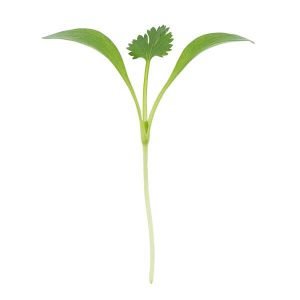You’ve probably already used coriander in your cooking and salads. But you may not have realized that cilantro is simply another name for the leaves of this herb, which originates from Africa, Asia, and even Southern Europe.
However, there is a difference! The seeds of the mature plant are generally referred to as coriander, while the leaves are known as cilantro. It’s the leaves that have the flavor and goodness that you want.
Cilantro microgreens are simply the process of producing fresh, young versions of these leaves in a very short space of time.

The great news is that it’s easy to start growing cilantro microgreens at home; you need very little space and they’ll be ready within a couple of weeks! That means you can have a nearly never-ending supply of this delicious herb.
Cilantro Microgreens Health Benefits
Cilantro microgreens may taste delicious, but that’s not the only reason to grow them. In fact, there are a number of health benefits:
- Protects Cells & Organs
There is a high number of carotenoids in cilantro. These are fat-soluble antioxidants which are essential for your body to protect your cells and organs from damage.
You may be surprised to learn that a serving of cilantro microgreens can contain as much of these carotenoids as a serving of carrots or sweet potatoes.
- Eye Protection
It’s worth noting separately that two of the carotenoids, lutein, and zeaxanthin; are essential to maintaining eye health as you age. Specifically, they have been linked to reducing age-related degeneration and cataracts.
- Blood Coagulation
The high levels of vitamin K in cilantro microgreens make them an excellent food choice to improve blood coagulation, (clotting). That’s important every time you cut yourself.
- Immune System Boost
Cilantro microgreens have a high level of vitamin E which is essential to your body for the proper function of your immune system.
One serving of cilantro microgreens can really boost the health of your body!
How to Grow Cilantro Microgreens
- Soak: No, these seeds are not actually very keen on water. Some people say it’s better to soak them (6 hours) so you need to experiment with this.
- Rinse/drain: No, there rarely need watering and definitely don’t want to be soaked and drained.
- Time to germinate: 2-3 days
- Time to harvest: Between 14 and 21 days.
Check out this step by step guide to how to grow cilantro microgreens:
Step 1 – Prep The Planting
The first stage is to select a tray in which to grow your cilantro microgreens. A good starting size is 10×20.
You’ll also need to select your growing medium. You can use soil but it is advisable to ensure it is sterilized. The best choice is a potting mix with vermiculite.
Top Tip: Cilantro is not keen on water, you need to ensure the growing medium is 1 inch deep as this will help it to retain moisture.
Step 2 – Plant Your Seeds
A 10×20 tray will take between 80-100 grams of dry (non-split) seeds, depending on whether you’re after microgreens or the slightly bigger ‘true leaves’.
Make sure you moisten the soil thoroughly before you sprinkle the seeds. To avoid puddles, use trays with holes in the bottom.
Once you watered your soil mix and sprinkled the seeds add another 1 inch of soil mix to the top of the seeds. This will encourage the seed hulls to fall off once they start to grow. If you don’t do this the seed hulls will still be attached to the top part of the microgreen, which you don’t want.
Now mist the topsoil to make it wet but not soaked. Now, cover up the tray to keep the moisture in and keep it in a dark place. It will take 5-9 days for cilantro to germinate.
Step 3 – Final Stages
It is worth checking the plants from day 5 onwards if there are any signs of wilting then water the growing medium, not the plants.
From day 7 onwards the cover can be removed and the plants moved to a sunnier location.
Monitor the plants but they will probably only need a little water every 3 days, and always water the growing medium – not the microgreens itself.
Step 4 – Ready To Harvest
Between day 14 and 21, the leaves will open and become greener, this means they are ready to harvest.
Bonus Tip: You can leave the plants for an extra week, allowing them to grow larger, this is known as true leaves; they have a slightly richer flavor.
FAQ
To help you get started here are the most commonly asked questions. If you don’ find your answer here then contact me, I can help.
When to harvest cilantro microgreens
Cilantro microgreens will be ready between days 14 and 21. Basically, as soon as they are completely green and open, they’re ready to harvest.
All you have to do is cut the stems as close to the growing medium as possible; you can wash them gently before eating.
How to get rid of mold on cilantro microgreens
Mold is always an issue in a damp environment. If you see any on your cilantro microgreens you’ll want to act fast.
You should move the plants to where they get more sunlight and greater airflow. It is also essential to ensure you trays and other equipment is cleaned properly before you start planting.
How to eat cilantro microgreens
They are the perfect accompaniment to any salad or as a garnish. You can even add them to scrambled eggs, your personal salsa recipe, or even a curry.
Useful Tip: Cooking cilantro microgreens will destroy the nutrients and the flavor; it’s best not to.
How to harvest cilantro microgreens
Harvesting is as simple as cutting the stems near to the growing medium. If you’re not sure whether they are ready then simply harvest a couple and taste them.
How to store cilantro microgreens
Like most microgreens, these plants do not really like to be stored. The first step is to make sure they are not watered for the last 12 hours before harvesting.
This will reduce their water content.
You can then place them between two paper towels and dab the gently, this will remove any excess water. They can then be stored in a sealed plastic bag or a container. It is best to put them in the refrigerator and use them within a few days.
What do cilantro microgreens taste like?
Cilantro microgreens has a citrus, lemon/lime flavor. It is relatively mild and simply adds a gentle warmth or kick to your food.
However, it should be noted that approximately 15% of people have a gene that detects aldehyde chemicals, this can make cilantro microgreens taste of soap!

Hi Nick,
Do I have to mist everyday after planting…?? Or is it ok if I put the planting tray in 1” deep water?? My cilantros never germinate, they get molds before germination. My germination medium is soil
Tray size6”*4”
Seeds 5-6gs broken and unbroken(have tried both)
Humidity 90%
Temp 80F
I grow them in balcony, no direct sunlight.
I stack each tray on top of each other n put weight on top n mist the seeds everyday 2times
Please help me know the reason for molds.
Hello Roma, It seems like it’s too humid. The mold appears because there is not enough airflow. I believe it will be okay once you get the humidity down a bit and open some vents to increase airflow.